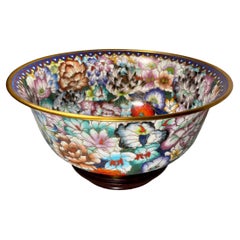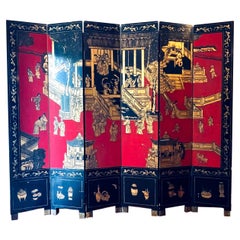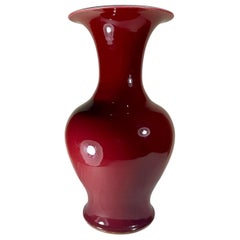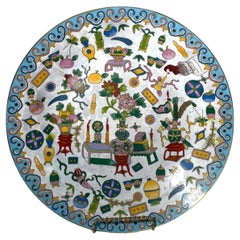Want more images or videos?
Request additional images or videos from the seller
1 of 10
Large Chinese Late Qing Dynasty Cinnabar Red Lacquer Vase
$975List Price
About the Item
- Dimensions:Height: 18.5 in (46.99 cm)Width: 10 in (25.4 cm)Depth: 10 in (25.4 cm)
- Style:Qing (Of the Period)
- Materials and Techniques:
- Place of Origin:
- Period:
- Date of Manufacture:circa 1910
- Condition:Wear consistent with age and use.
- Seller Location:Vero Beach, FL
- Reference Number:1stDibs: LU3915316569922
About the Seller
4.8
Gold Seller
Premium sellers maintaining a 4.3+ rating and 24-hour response times
Established in 2018
1stDibs seller since 2018
236 sales on 1stDibs
Authenticity Guarantee
In the unlikely event there’s an issue with an item’s authenticity, contact us within 1 year for a full refund. DetailsMoney-Back Guarantee
If your item is not as described, is damaged in transit, or does not arrive, contact us within 7 days for a full refund. Details24-Hour Cancellation
You have a 24-hour grace period in which to reconsider your purchase, with no questions asked.Vetted Professional Sellers
Our world-class sellers must adhere to strict standards for service and quality, maintaining the integrity of our listings.Price-Match Guarantee
If you find that a seller listed the same item for a lower price elsewhere, we’ll match it.Trusted Global Delivery
Our best-in-class carrier network provides specialized shipping options worldwide, including custom delivery.You May Also Like
Post Qing Dynasty Cinnabar Ginger Jar & Stand
Located in West Palm Beach, FL
Post Qing Dynasty Cinnabar ginger jar & stand
Exquisite high relief carved continuous landscape motif, complete with hardwood stand. Unmarked.
T...
Category
Early 20th Century Chinese Chinese Export Lacquer
Materials
Hardwood, Lacquer
Chinese Cinnabar Lacquer Cuspidor
Located in New Orleans, LA
This intriguing Chinese zhadou is intricately carved of fine cinnabar lacquer. A work of exceptional artistry, this covered bowl is adorned with an intricately carved floral motif on all surfaces, including the cover and the wide rim. Also known as a cuspidor or spittoon, this rare container would have been used by members of the imperial family and scholar- officials at the court. Carved during the Kangxi period (1662-1722), this charming piece exhibits the high detail and charm associated with items from that period, making it a true treasure,
Early 18th century (Kangxi dynasty)
Measures: 6 ¼” wide x 3 ¼” high
Cinnabar has been revered for its color all over the world. It has been found in the royal burial chambers of the Mayas, in the rituals of India, and in the ruins of ancient Greece and Rome. In China, cinnabar and gold were the two most important elements in alchemy. Mined since the Neolithic Age, cinnabar is the ore of mercury, and as such, it can be incredibly toxic, especially when mining. In fact, during the Roman Empire, miners at Spain’s Almadén mine in Spain were frequently exposed to mercury fumes, and the subsequent, often fatal, sickness was considered an occupational hazard.
The most popular known use of cinnabar is in Chinese carved lacquer-ware, a technique that is believed to have originated in the Song Dynasty, in which cinnabar is ground to a powder and added to clear lacquer. As with mining, there was inherent danger of mercury poisoning for those who carved the lacquer, as mercury was also released into the air when artisans ground the pigments. Most antique cinnabar...
Category
Antique 18th Century Chinese Other Lacquer
Materials
Lacquer
Large Chinese Cinnabar Lacquered Vase
Located in San Diego, CA
A very large, well crafted Chinese cinnabar lacquered vase with copper / brass lining, circa 1950's. The vase are 19" high and 9" in diam...
Category
Mid-20th Century Chinese Vases
Materials
Brass, Copper
Late 19th/ early 20th Century Large Red Lacquer Offering Tray, Burma
Located in Point Richmond, CA
Large Red Offering Tray, Burma
Late 19th/early 20th century
Bamboo, lacquer ...
Category
Early 20th Century Burmese Tribal Lacquer
Materials
Bamboo, Lacquer
Late 19th/ early 20th Century Large Red Lacquer Offering Bowl, Burma
Located in Point Richmond, CA
Large Red Offering Bowl
Burma
Late 19th/early 20th century
Bamboo, lacquer
D: 31 in x H: 7.5 in :: 78.7 cm x 19 cm
Traditionally used to bring offerings to an altar, and to present ...
Category
Early 20th Century Burmese Tribal Lacquer
Materials
Bamboo, Lacquer
Large Chinese Carved Nephrite Jade Double Buddha's Hand Vase, Late Qing Dynasty
Located in Austin, TX
A large and graceful carved nephrite jade conjoined double vase in the form of a pair of Buddha's hands fruit (finger citron), late Qing Dynasty, circa 1900, China.
The large and heavy vase carved from a single piece of celadon nephrite jade, with areas of lighter brown "sugar" skin. The vase ingeniously carved as a pair of Buddha's hand fruit, also known as finger citron, rising from a gnarled, leafy branch. The smaller Buddha's hand with a pair of bats. The Buddha's hands fruit with elegant and naturalistic curved "fingers". The "fingers wonderfully shaped and reticulated. The body of the fruit with simple stippling, in imitation of the textured surface of the real fruit. The interior of each fruit well hollowed and able to hold water.
Buddha's hands fruit are auspicious in Chinese culture. Their name in Chinese "Fo Shou" is a homophone for "Happiness and Longevity. They are often placed as offerings on Buddhist altars...
Category
Antique Early 1900s Chinese Qing Sculptures and Carvings
Materials
Jade
$9,800
H 8.75 in W 6.25 in D 3.5 in
Chinese Qing Lacquered and Inlaid Handled Sewing Box
Located in Bishop's Stortford, Hertfordshire
An unusual and fine antique Chinese Qing lacquered and inlaid papier mache handled sewing box with decorative panels dating from latter 19th or early 20th century. The sewing box is of round cylindrical shape with a swing carry handle and is inlaid with mother of pearl and abalone. The body is made up of eight oval shaped scenes of typical Chinese style with buildings and people picked out with inset abalone and mother of pearl and highlighted and contained within a gilded border. These are set between bands of patterned abalone and against a blue silk background. A similar band of abalone is applied to the swing handle. The cover sits within a recess and is made up of bands on inset abalone with cut out triangular designs and set over blue silk with a small finely carved mother of pearl handle...
Category
Antique 19th Century Chinese Qing Lacquer
Materials
Abalone, Mother-of-Pearl, Silk, Lacquer
$634 Sale Price
40% Off
Free Shipping
H 3.75 in Dm 5.12 in
Chinese Qing Dynasty Pair of Vases
Located in Dublin 8, IE
Chinese Qing Dynasty pair of baluster vases of hexagonal form, the everted scalloped rim of white ground raised over tapering neck with pair of recumbent tigers in green glaze cast i...
Category
Antique Early 19th Century Chinese Qing Vases
Materials
Porcelain
Qing Dynasty Large Canton Famille Rose Chinese Porcelain Vase
Located in Brea, CA
Qing Dynasty large 23.75” canton famille rose Chinese porcelain vase with two panels of figures and horses, the sides with birds and flowers double pairs of dogs handles and 2 pairs ...
Category
Antique Late 19th Century Chinese Qing Antiquities
Materials
Porcelain
Large Chinese Cinnabar Lacquered with Handles Vase
Located in Palm Springs, CA
Large well crafted Chinese cinnabar lacquered vase with handles and brass lining.
Category
Vintage 1960s Chinese Vases
Materials
Brass
More From This Seller
View AllLarge Chinese Cloisonne Enamel Bowl, Qing Dynasty
Located in Vero Beach, FL
Large Chinese Cloisonne enamel bowl, Qing Dynasty
Exceptional and finely decorated Chinese cloisonne punch bowl with gilt
metal foot and rim. The bowl has slightly flaring sides ...
Category
Early 20th Century Chinese Qing Metalwork
Materials
Copper, Enamel
$1,313 Sale Price
24% Off
Chinese Export Coromandel Lacquer and Gilt Six Fold Screen
Located in Vero Beach, FL
Chinese Export Coromandel lacquer and gilt six fold screen.
Exceptional and rare six panel intaglio lacquer carving from the mid-20th century. It depi...
Category
Mid-20th Century Chinese Chinese Export Paintings and Screens
Materials
Wood
Chinese Qing Dynasty Sang de Boeuf Bulbous Vase.
Located in Vero Beach, FL
Magnificent Chinese porcelain monochrome ox-blood vase with a stout rounded body and a long elegant flaring neck. It was created in the first half of the 20th century. Monochrome gla...
Category
20th Century Chinese Qing More Asian Art, Objects and Furniture
Materials
Porcelain
Large Chinese Qing Dynasty Polychrome Enamel Bronze Cloisonne Charger
Located in Vero Beach, FL
Large Chinese Qing Dynasty polychrome enamel bronze cloisonne charger.
Unusual and rare bronze Chinese Qing Dynasty Cloisonne charger. The brightly ...
Category
Early 20th Century Chinese Qing Metalwork
Materials
Bronze, Enamel
Chinese Qing Dynasty Small Bronze Tripod Censer
Located in Vero Beach, FL
Chinese Qing Dynasty Small Bronze Tripod Censer
Small bronze censer from the Qing Dynasty 1644-1912, standing on three cabriole legs. Twin handles depict mythical creatures’ heads. ...
Category
Antique 19th Century Chinese Qing Metalwork
Materials
Bronze
Pair of Chinese Qing Dynasty Openwork Wall Hanging Giltwood Carvings
Located in Vero Beach, FL
Antique pair of Chinese 18th century Qing dynasty openwork wood carving
Gilded screen work wall hanging architectural elements.
This pair of Chinese pan...
Category
Antique 19th Century Chinese Qing Architectural Elements
Materials
Giltwood
$1,015 Sale Price / set
30% Off
Recently Viewed
View AllMore Ways To Browse
Chinese Lacquered Vases
Asian Cinnabar
Chinese Carved Cinnabar Red Lacquer
Cinnabar Vase
Chinese Cinnabar Lacquer Vase
Large Cinnabar
Chinese Red Lacquer Vase
Antique Chinese Cinnabar Vase
Red Cinnabar Lacquer Vase
Black Lacquer With Gold Art
Japanese Lacquered Art
Japanese 19th Century Lacquer
Asian Black Lacquer Furniture
Vintage Japanese Lacquer
Japanese Lacquer Meiji
Mother Of Pearl Inlay Lacquer
Japan Edo Lacquer
Antique Asian Mother Of Pearl Furniture



